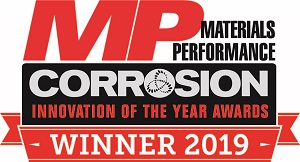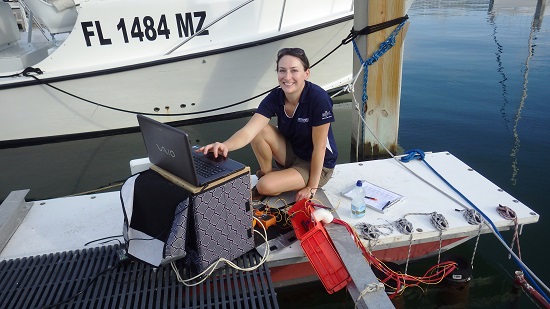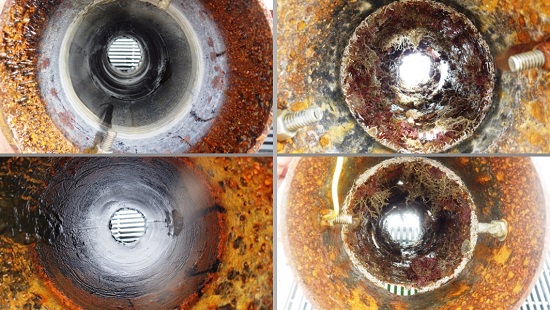A newly designed perforated offshore monopile system could help mitigate corrosion within the often flooded interiors of offshore wind turbine support structures, as well as potentially provide habitats for fish and other marine organisms.
Though retrofitting monopile interiors with cathodic protection (CP) has been attempted on existing offshore wind farms to mitigate corrosion, the new system’s developers say this route can cause new problems including water acidification and hydrogen sulfide (H2S) formation, which can lead to unique localized corrosion concerns.
 By contrast, the perforated monopile structure—which was one of 10 winners in the 2019 MP Corrosion Innovation of the Year Awards program—aims to create an environment with more favorable corrosion mitigation, air quality, and water chemistry compared to a sealed structure. Full mechanical details and case histories are available at the awards web site.
By contrast, the perforated monopile structure—which was one of 10 winners in the 2019 MP Corrosion Innovation of the Year Awards program—aims to create an environment with more favorable corrosion mitigation, air quality, and water chemistry compared to a sealed structure. Full mechanical details and case histories are available at the awards web site.
“Perforations are created in the sides of submerged monopoles allowing the free circulation of the surrounding seawater,” explains Monica M. Maher, a graduate student at the Florida Institute of Technology’s Center for Corrosion and Biofouling Control (Florida Tech) (Melbourne, Florida, USA). Maher and Geoffrey Swain, a professor in the school’s ocean engineering discipline, collaborated on the system’s development.
“Water inside the internal compartment maintains chemistry properties similar to ambient seawater,” Maher adds. “Perforated monopile interior walls can more easily and predictably be protected from corrosion using CP because the design requirements are similar to the exterior surfaces. Biofouling and mobile organisms also enter the monopile, and a sheltered habitat is established.”
Related Case Studies
According to Maher, active corrosion mitigation was once considered unnecessary on sealed monopile submerged interior surfaces, as oxygen would be consumed during some initial corrosion. From there, the anaerobic stagnant water would not fuel further corrosion.
However, in several case studies, oxygenated seawater ingress through conduit penetrations or cracked grout caused higher than anticipated corrosion rates on some early wind farm foundations, she explains. The chemistry problems were attributed to the use of aluminum anodes in a closed space with stagnant seawater.
In a field experiment conducted by Maher from August through October 2018, she found similar chemistry problems when using a sacrificial zinc-anode CP system in a sealed submerged interior compartment. However, the same zinc CP system installed in a compartment with perforated walls was more easily and predictably protected from corrosion while maintaining neutral seawater chemistry. Since surrounding water is constantly flushing the interior space, Maher says CP can be designed similarly as on external surfaces. Furthermore, the pipe’s interior may become colonized by an assemblage of benthic marine organisms, crabs, shrimp, and fish.
Setting Up New Experiments
In Maher’s experiment, pipes of 1 m length and 15 cm diameter were deployed to represent scaled down monopiles of ~5 m in diameter and 40 m in length. “There were four different treatments, including two sealed pipes and two perforated ones,” she says. “In each pair, there was a freely corroding pipe and a cathodically protected pipe with a zinc sacrificial anode. The sealed unprotected treatment represents originally installed wind farms, and perforated treatments were considered in this trial as a potential improved design. To be consistent with monopiles driven into the seabed, each pipe had a layer of local sediment at the bottom, seawater filled most of the pipe, and an air gap was left at the top.”

Inside each pipe were three sets of steel coupons removable for analysis, as well as a silver/silver chloride (Ag/AgCl) reference electrode for potential measurements, and a counter electrode at the middle coupon set for polarization. Each steel coupon was made from a small piece of flat bar with 30 cm2 surface area. The pipes were hung from a floating dock so the water level inside and around the pipes did not oscillate with tides.
Weekly measurements were taken related to steel corrosion and internal water chemistry. A potentiostat, ramp generator, and data logger measured potentiodynamic polarization on one set of steel coupons in each pipe, while probes measured pH and dissolved oxygen (DO) levels.
First, the potential of the pipe, coupons, and zinc anode system was recorded and referenced to the Ag/AgCl electrode. Then, the middle set of three coupons were disconnected from the structure and given time to normalize. The middle set was polarized cathodically and returned to its rest potential, with the applied potential and current response recorded. After waiting an hour to normalize again, the middle coupon set was polarized anodically and again returned to its rest potential while recording both the applied potential and current response.
Salinity, temperature, DO, and pH were measured using the probes and tracked over time. DO was quickly reduced in the sealed pipes, in line with the theory of oxygen getting consumed during initial corrosion. However, DO in the perforated pipes matched that of ambient seawater for the first month. The decrease in the second month could be explained by the growing biological community consuming oxygen, Maher says.
The ambient seawater maintained a neutral pH level of near 8. In the sealed unprotected treatment, pH increased after oxygen was reduced. In contrast, acidification occurred in the sealed pipe with the zinc anode, similar to recent field trials with aluminum anodes. However, the perforated pipe maintained a pH level similar to the neutral ambient seawater.
The rest potential of the pipe system was measured with the weekly reference Ag/AgCl. Though the four treatments quickly developed different potentials, adequate protection was achieved and maintained for both the sealed and perforated treatments with zinc sacrificial anodes to keep the steel immune from corrosion.
Each week, the middle set of coupons in each pipe was polarized cathodically and anodically at 100 mV. From there, the applied voltage was plotted against the measured current response. The cathodic polarization slopes were compared. According to Maher, the sealed cathodically protected treatment had the highest resistance, while the perforated freely corroding treatment had the lowest resistance. The cathodic polarizations of the sealed freely corroding and perforated cathodically protected steel were similar. The cathodic polarization resistance increased with a reduction of available oxygen and with the formation of cathodic chalks.
Experimental Findings
At the experiment’s end, steel surfaces were analyzed for corrosion and biofouling. The coupons in the sealed, freely corroding treatment had black and orange corrosion products. This treatment represents the originally installed unprotected windfarm structure interiors, Maher says.

The coupons in the CP-sealed treatment had no corrosion and a thick zinc carbonate film on the submerged surfaces. The perforated, freely corroding treatment had biofouling and corrosion products. The perforated, cathodically protected treatment had no corrosion, and surfaces were colonized by a healthy biofouling community. The sealed pipes had no macrofouling and were biologically unproductive.
Scanning electron microscopy (SEM) elemental analysis showed the freely corroding submerged surfaces had iron oxide corrosion products. The sealed, cathodically protected submerged surfaces were covered by zinc carbonate (ZnCO3) and the open cathodically protected surfaces by cathodic chalks. The splash zones of all the pipes exhibited raised corrosion products.
The interior surfaces of both perforated pipes were covered in biofouling. There were, however, significant differences in the community structure. The marine growth inside the freely corroding pipe was impoverished due to sloughing caused by corrosion of the steel. This prevented the development of a stable community, and it also led to the accumulation of dead organisms at the base of the pipe that created anoxic muds.
In contrast, the marine growth in the cathodically protected pipe developed into a more diverse and stable benthic community which formed a habitat for crabs, shrimp, and fish. In the years ahead, Maher believes these types of regional ecology and economic benefits could help earn additional public support for the offshore wind farm industry.
Next Commercialization Steps
Moving forward, Maher says the next step in making the innovation commercially available is to transfer the knowledge to the industry and to strategically design perforations to be incorporated within the monopile configurations. Challenges could include modelling the changes in wave and current loading, as well as modifying the corresponding changes in monopile dimensions and wall thickness, she explains. However, the system’s upside remains considerable.
“This innovation can be incorporated into the design of offshore wind turbine support structures,” Maher explains. “Effective, predictable CP will extend the service life of structure foundations and avoid the creation of hazardous confined work spaces for maintenance activities.”
Source: Center for Corrosion and Biofouling Control, Florida Institute of Technology, research.fit.edu/ccbc. Contact Monica Maher—email: mmaher2006@my.fit.edu and Geoffrey Swain—email: swain@fit.edu.